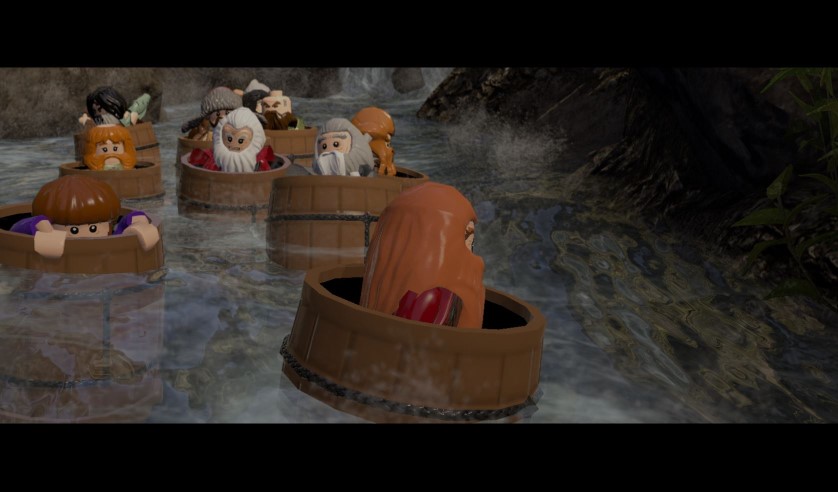TT Games certainly has been busy lately. Not too long ago we reviewed The Lego Movie Videogame, and hot on its heels comes the Lego version of The Hobbit. You might want to refer back to our review of Lego Lord of the Rings, because this is going to be a “what’s different” kind of review. Ready? Good…let’s break some things.
Lego The Hobbit tells the tale of the first two Hobbit films. Why not wait until the third film was done? Your guess is about as good as anyone’s actually. Perhaps they needed to get to work on the next Lego game and had to have this one finished first? Perhaps aliens were attacking, and it were best that this game get done, because the movie’s not going to make it? Maybe because the kitchen sink was overflowing again, and the game needed to be out because the fiddle sticks were all in the wrong order. Either way, it’s a bizarre decision probably made by someone who knows a lot about business but not much about video games or fandoms or logic.
Gameplay hasn’t changed that drastically from Lego Lord of the Rings. The non-story area is still the entire explorable section of Middle Earth, and the game’s collectibles are epic in number. What has changed—quite drastically, I might add—is that Middle Earth now features a crazy number of extra areas in the form of caves dotted around the landscape. The caves are usually filled with puzzles to be solved in exchange for more loot. Another big change is the “buddy up” system, which allows a single player to pair up two characters to perform bigger actions that a single small one can’t. For example, the dwarves, being small, have trouble embedding an axe into the skull of a troll, so it makes sense that you pair two dwarves up, and have one use the other as a proxy weapon. Why bury an axe into a troll when you can bury an entire dwarf?
Another change is that now, upon breaking something (this means everything), instead of just Lego studs (money!), the broken objects also generate building materials such as wood, rope, gold, rubies, or diamonds. You use these objects at build platforms to create Lego structures that help you progress through the game. Sometimes it’s fairly simple, and you have all the requisite gewgaws and doodads. What usually ends up happening, however, is this conversation with yourself: “Bugger. This thing needs 80 units of iron. I have 79. Where the HELL am I going to find some iron now?” And off you traipse on a journey around the countryside in search of iron. Except you get sidetracked by a partially-hidden cave entrance or sidequest, and you’ve forgotten about the iron you wanted until two and half hours later, after you’d used all 260 units of iron in a sidequest building some fat hobbit a bed. You find yourself back where you started, and then go “Oh. I needed those, didn’t I? Bugger. Iron, was it?” And off you go again. In fact, you can spend an incredible number of jolly hours NOT playing the story mode, because the sandbox hub is just so much more fun.
One things that will drive you as crazy as sure as orcs will stink is that giving you 12 dwarves—14 characters if you include Bilbo and Gandalf—at the outset, each with a different ability, means that you’re going to struggle to find the one character you need to perform any given task. Fili, for example, has a spade and can dig stuff up. Dori has a flail and can pull on gold studs. But which one was Fili and which one was Kili and what the hell was Bofur for again? It turns out to be a confusing mess at that point, which makes some of the puzzle solving a bit silly. Not that the puzzles are anything difficult; this IS a game for kids, after all. However, it’s been dumbed down even further by the existence of these hint blocks that you’ll find littered about the landscape, as if some mad wizard made too many and discarded them all at random in really, really convenient locations.
That all being said, Lego games use a formula that works, and if nothing else, it all provides a sense of comfortable familiarity, which is especially wonderful for the game’s younger players. I just wish there was something there for us older players who enjoy these games just as much. There’s not much more I can add than that—it’s fun, it’s playful, it’s charming, but don’t expect innovation. There’s an insane amount of gameplay here, so if you’re expecting value-for-money, you’ll find it by the boatload. Now if you’ll excuse me: my son and I have a few more sidequests to complete. Oh wait…iron, was it?
Final score: 6.5 Dwarf-sized prawns out of 10
Detailed information:
Developer: TT Games
Publisher: WB Games
Distributor: Ster Kinekor Games
Age Rating: PEGI 6
Platforms: Everything except your printer
Website: http://thehobbit.lego.com/en-us/videogame





